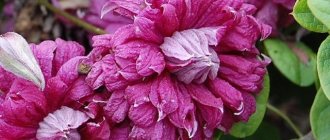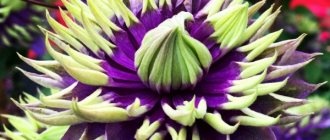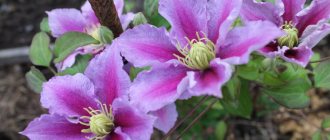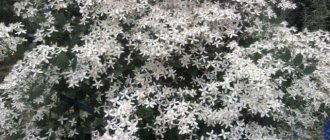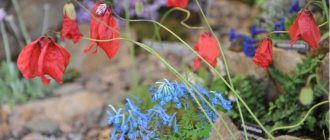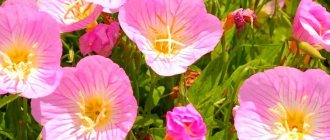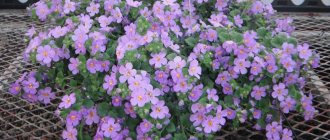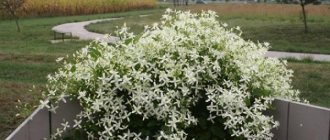15.09.2019
Categories: purple, large-flowered, pruning group 3, winter-hardy, for the Moscow region
There is no such amount of contradictory and simply delusional information about any clematis or clematis as about Jacquemman's clematis. This is due to the changing classification of varieties and the popularity of the Jackmanii variety. In this article I will try to explain everything. So:
- Clematis Jacquemant does not exist as a species and never has existed.
- In the old classification of clematis varieties there was a group of Jackman or Jackman (Jackmanii). It included varieties obtained by crossing purple clematis (Clematis vitalba) and varietal clematis of the Patens group. The group has now been abolished due to the inability to accurately determine the origin of many varieties, and also because many varieties have very complex origins. In the new, now generally accepted classification according to Matthews, the Jackmanii group is combined with the Lanuginosa group into one common large group “Late-flowering large-flowered clematis”.
- There is also a clematis variety, "Zhakmani" or "Jekmani", which is part of a new group of large-flowered, late-blooming clematis. Below is a description, photo, etc. of this variety.
The clematis variety "Jackmany" was obtained by the British florist George Jackman (Jackman) Jr. in 1858 as a result of crossing the woolly clematis (Clematis lanuginosa) and the clematis variety (Clematis diversifolia) "Hendersonii". The first flowers appeared in 1862, and already in 1863 the variety was introduced. This is the modern idea. However, in William Robinson's book "The Virgin's Bower", published in 1912, the following is written about Jacquemin's clematis:
“This plant, according to Monsieur Lavally, is a Japanese species, and not a hybrid, as previously thought. In fact, this is so; this plant is well known to botanists who collected collections in Japan.”
What was quoted is completely incorrect: records of Jackman’s breeding work have been preserved and they confirm his authorship. However, there are other arguments.
Caption under Mike Denny's photograph of an old plant - "the result of a cutting from a twenty-year-old plant taken 30 years ago"
. Mike's father, Vince Denny, considered this plant to be a specimen of the variety. Nothing further is clear from the English text, but it is noted that the plant shown in the photo is common in Japan.
In fact, none of these forms are the original clematis 'Jackmanii'. In the 2005 edition of the British Clematis Society Journal, Wim Sneuger wrote that the modern Jackmany clematis is not like its description and depiction in the classic 1872 book, Clematis as a Garden Flower, written by Moore and Jackman, which has gone through many reprints. However, modern specimens correspond to the 1881 herbarium. From this we can conclude that the original clematis of Jacqueman or Jackman was lost a very long time ago.
Description of Clematis Jacquemman
Clematis Jacquemman is widely known among ornamental trees and shrubs. The Jacqueman group includes various hybrid varieties. It was named after one of the outstanding varieties, on the basis of which all the others had already been bred. The very first Jackman clematis was bred in 1858 by English breeders in the Jackman nursery.
The height of plants, as a rule, reaches 4 - 5 meters. The greyish-brown stem of the vine is highly branched, slightly pubescent and ribbed. The odd-pinnate dark green leaves are formed from 3 - 5 leaves. The width of the leaves is about 5 cm, the length is about 10 cm. The shape of the leaves is elongated, ovoid, pointed, and has a wedge-shaped base.
As you can see from the photo, the flowers of Jacquemand's clematis are large and very beautiful. They sit alone, extremely rarely - 2-3 pieces. The size of flowers in diameter, on average, is 7 - 15 cm, but there are varieties with larger flowers. Their color can be very diverse: white, red, pink, purple, blue or light blue.
In temperate climates, the buds of clematis from the Jacquemman group swell in April, and the leaves bloom in May. Until the end of June, the vine shoots are actively growing, after which abundant flowering begins, which usually ends only in August. Weak flowering sometimes continues until September.
Characteristics of culture
Clematis Jackmanii is not a separate variety, but a whole group that includes hybrid varieties with similar characteristics and requirements for growing conditions. All of them are united by high winter hardiness, excellent immunity to diseases, lush and abundant flowering and accelerated growth. Jacquemin's clematis does not occur in nature, but it is successfully grown as an ornamental plant in garden plots.
The clematis group received its name from the name of the first variety of this category, which gardeners saw in 1858. He was bred at the Jackman nursery located in England. Within a few years, breeders from different countries began to develop more and more hybrids based on it. According to modern classification, today this group of clematis includes more than 90 varieties obtained artificially by foreign and domestic gardeners.
Clematis belonging to the Jacquemman group differ in the shade of the petals, the size of the buds, and the duration of flowering, but there are also characteristics common to all hybrids.
First of all, these plants have a powerful root system, which allows them to take root without problems in a new place. In length, such crops reach 4 meters with proper care - this is one of the highest values among all clematis. Perennial plants begin to bloom at the end of May, the process continues until September - the exact timing depends on the specific hybrid. Since representatives of the Jacqueman group belong to the 3rd pruning group, flowering occurs on the shoots of the current year. For winter, crops require radical pruning.
The size of the buds varies from 5 to 20 cm, and the color range is predominantly purple or blue-violet. The flowers have an elongated conical shape and are directed downward or sideways. The ellipsoidal petals have pointed tips and curl outward. There are from 4 to 7 of them in a bud. Clematis flowers are mostly simple, not double in shape. Representatives of Jacquemin's group, despite their popularity, are not included in the State Register of Russia.
Clematis varieties of the Jacquemman group
There are many different varieties of Jacquemman's clematis: photos of crops show that they all differ in size, color and shape of flowers, appearance of leaves and length of shoots. The article lists the most popular varieties of clematis Jacquemman, recommended by Russian gardeners.
Important! Some varieties of clematis have similar names, but do not belong to the Jacquemman group. For example, clematis Jacqueman Alba belongs to the Florida group, and clematis Barbara Jacqueman belongs to the Patens group.
Superba
Clematis Jacquemin Superba is a shrubby deciduous vine that can grow up to 3 m in length. The inflorescences are wide-open, velvety, consist of four petals of a deep purple color, and have anthers of a slightly greenish tint. In the center of the petals there is a purple stripe that fades as the flower ages. Clematis buds Jacqueman Superba, collected in the axils in several pieces, look like a half-umbrella.
Flowering usually begins in May and ends in September. Cold weather can delay flowering time. The variety is characterized by average winter hardiness.
Rouge Cardinal
Clematis Rouge Cardinal is a hybrid variety from the Jacqueman group, developed by French breeders, which has received many world awards. The dark purple velvety flowers of the vine are quite large, their diameter is approximately 15 cm. The inflorescences themselves are cross-shaped. The flower is complemented by contrasting stamens of a light, milky shade.
Shoots of clematis Rouge cardinal grow up to 2 - 2.5 m. The medium-sized leaves have a trifoliate shape. The leaf blade is painted in a dark green shade. The plant blooms from July to September. The variety is considered moderately frost-resistant.
Cosmic Melody
The clematis variety Cosmic Melody, developed by domestic breeders in 1965, also belongs to Jacqueman’s group. The plant was named Cosmic Melody in honor of the flights of Russian cosmonauts. This is a shrubby vine that reaches a height of 3 m. The bush is usually formed from 15 - 30 shoots. According to manufacturers, the Cosmic Melody variety has exceptional frost resistance.
From 10 to 30 flowers can grow on one shoot. The diameter of the opened flowers is 12 - 14 cm. They consist of 5 - 6 velvety petals of a purple-cherry hue, having a diamond shape. The petals of clematis Cosmic Melody do not adjoin each other closely: there is some distance between them. This arrangement can be considered a distinctive feature of the variety.
Important! The color of clematis petals in bright sun may become paler over time.
Luther Burbank
Luther Burbank is one of the clematis varieties of the Jacquemman group, which has perhaps the largest flowers, the size of which reaches 20 cm in diameter. The liana is also characterized by rapid growth, the shoots stretch up to 2.5 - 4 m. The bush is formed by about 10 shoots.
One shoot of clematis Luther Burbank contains from 9 to 12 flowers. The flowers are violet-purple in color and have 5 - 6 pointed petals. The edges of the petals are wavy. Stamens are yellow-white. Flowering continues from July to September. Clematis Jacquemand Luther Burbank can withstand frosts down to -30 degrees.
Anna German
Clematis Anna German is another variety of the Jacqueman group, bred by domestic breeders in 1972 in honor of the famous Polish singer. The height of the plant is about 2 - 2.5 m. The vine blooms early, closer to mid-May. In favorable conditions, it can bloom again in August. Clematis Jacqueman Anna German is well adapted to the Russian climate; it can withstand even severe frosts down to -40 degrees.
The flowers of the plant are very large, from 16 to 20 cm in diameter, and have a star shape. They consist of petals of a soft purple or soft lilac color. The color of the petals is lighter in the center and richer at the edges, the stamens are yellowish. The variety is considered a moderate grower, so it can even be grown on a balcony in containers.
Gypsy Queen
Clematis Jacquemand Gypsy Queen is a shrubby vine formed by about 15 shoots, the maximum length of which is 3.5 m. The plant can be grown in a container. A distinctive feature of the variety is the slightly raised buds. The liana begins to bloom in late July or early August.
The size of the dark purple flowers of the vine is about 15 cm. The petals are velvety and quite wide. After the flower has fully matured, the anthers also acquire a purple color.
Important! Unlike many varieties of the Jacquemin group, the flowers of clematis Gypsy Queen do not fade when exposed to the bright summer sun.
Nellie Moser
Clematis variety Nelly Moser is a deciduous vine from the Jacquemman group. The height of the plant is about 2 - 2.5 m. The flowers of the vine are painted in a very delicate, light, mauve shade. The anthers are two-colored: white and deep purple. There is a bright pink stripe in the center of the petals. In appearance, the petals resemble a slightly pointed ellipse. The shape of the flowers is star-shaped, with a diameter of 12 - 18 cm.
The liana blooms in May or June, and re-blooming begins in August or September. The clematis variety Nelly Moser belongs to the 4th winter hardiness zone and can withstand frosts down to -35 degrees.
Moonlight
In 1958, the clematis variety Jacqueman Moonlight was developed by the Russian scientist A. N. Volosenko-Valenis. The liana is vigorous, the shoots grow up to 3 m in length. Compound leaves are formed by 3, 5 or 7 leaflets. Flowering begins in June or July. The crop is suitable for cultivation in all climatic zones of Russia.
The shoots of the vine are strewn with shiny flowers of a lavender hue with a transition to blue towards the center. The size of the flowers ranges from 8 to 12 cm. Flowers are often formed from 4 petals, much less often from 5 or 6. The shape of the petals is rhombic, with pointed ends, often bent outward. The stamens are light, pale green.
Texa
The clematis variety Jacqueman Tex was bred in 1981 by the Estonian breeder U. J. Kivistik. Tex's clematis are not too tall, which allows them to be grown in containers on the balcony. The liana blooms in June or July; re-blooming should be expected in early September.
The diameter of the flowers is 14 cm. The petals have wavy edges and pointed tips. The flowers consist of 6 petals, painted in a bluish color, reminiscent of worn denim in appearance, since the surface of the petals is evenly strewn with light inclusions. The anthers have a grayish-purple tint.
Ernest Markham
Clematis Ernest Markham is one of the most popular varieties of the Jacquemman group, bred in 1936 and to this day known for its bright crimson inflorescences. This is a perennial vine, the maximum shoot length of which is 3.5 m. This variety of clematis is very frost-resistant and can withstand cold temperatures down to -35 degrees.
The flowering of this vine is quite long, lasting from June to August. The flowers are large, up to 15 cm in diameter, formed by 5 - 6 overlapping velvety, wavy, slightly pointed petals. The stamens are cream-colored.
Clematis groups
The clemetis group is a union of varieties obtained on the same basis, which have external similarities and care recommendations. Based on belonging to a certain group of clematis, it will not be difficult to organize the care of a beautifully weaving plant: planting, pruning, fertilizing and watering.
Types, varieties and groups of clematis - video
Grouping of plants:
- Lanuginosa;
- Patens;
- Florida;
- Viticella;
- Intergrifolia (Integriflora);
- Flammula-Recta;
- Orientalis;
- Atragene (Atragene).
Clematis group Lanuginosa
Lanuginosa plants are vines, of the shrub type.
The popular varieties of clematis of the Lanuginosa group are:
- "Flower Ball";
- "Anna German";
- "Ballerina";
- "Hope".
Clematis group Patens
Patens are shrubby vines with fairly large inflorescences. need careful preparation for winter.
The popular varieties of clematis of the Patens group are:
- "William Kenneth";
- "Girenas" (Girenas);
- "Andromeda";
- "Multi Blue" (Multi Blue);
- "The Fest Lady";
- "Blue Light";
- "Arctic Queen" (Arctic Queen);
- "The president".
Clematis group Florida
Clematis of the group of shrub-type vines have long shoots of 300 cm. This group of clematis is moderately resistant to frost,
The most popular clematis varieties of the Florida group are:
- "Cassis" (Chassis);
- "Alba Plena" (Albina Plena);
- "Geoffrey Tolver" (Geoffrey Tolver).
Clematis Viticella group
The Viticella group includes clematis with climbing vines. Another advantage is that there is no need to cover these plants. It is enough to prune them lightly in the spring to renew the bush and stimulate flowering. The most popular varieties of clematis Viticella are:
- "Cardinal Vishnevsky";
- "Allanach";
- "Jadviga Valenis" (Jadviga Valenis);
- "Nikolai Rubtsov";
- "Victoria";
- "Blue flame";
- "Warsaw Night";
- "Madam Julia Correvon" (Madam Julia Correvon).
Clematis group Intergrifolia
Clematis of the Integriflora group are herbaceous subshrubs. Before wintering or spring, the lashes are cut to 100 cm.
Popular varieties of clematis Intergrifolia are:
- "Blue bird";
- "Dominica";
- "Alba";
- "Alyonushka";
- "Arabella".
Clematis group Flamula-Rekta
Clematis Flammula-Recta is a herbaceous plant with small inflorescences. It is worth recognizing that in the form of landscaping on vertical supports, clematis Flamula-Recta look more attractive. Popular varieties of clematis Flamula-Recta are:
- "Burning";
- "Fragrant";
- "Straight";
- "Manchurian";
- "Grape-leaved."
Clematis group Jacquemman
These clematis were formed on the basis of the hybrid variety Jacqueman. Popular varieties of Jacquemin's clematis are:
- "Comtesse de Bouchaud" (Comtesse de Bouchaud);
- "Victoria";
- "Rouge Cardinal" (Rouge Cardinal);
- "Westerplatte" (Westerplatte).
Clematis group Orientalis
Clematis of the Orientalis group have one common feature - the yellow color of the buds. Popular varieties of clematis Orientalis are:
- "Tangut"
- "Serrated";
- "Oriental".
Clematis group Atragene
Clematis Atragene is a herbaceous vine known to flower growers as Knyazhiki. The Atragene clematis varieties that gardeners love are:
- "Estrella" (Estrella);
- "Rosy O'Grady" (Rosie O. Grady);
- "Jan Lindmark" (Jean Lindmark);
- "Markham's Pink" (Markham's Pink);
- "BlueDancer" (Blue Dancer);
- "PinkFlamingo" (Pink Flamingo).
Photo of clematis "PinkFlamingo" (Pink Flamingo)
So, if a gardener lives in a harsh climate, then he should consider purchasing clematis from the groups Atragene, Jacqueman, Vititsella, Intergrifolia - these are the most frost-resistant plants. Clematis can be divided into liana-types, shrubs and subshrubs.
Optimal growing conditions
Clematis of the Jacquemman group are fast-growing vines. For comfortable growth, they usually require a large amount of light. The place should be protected from the wind, since clematis flowers are so delicate that they cannot withstand its strong gusts.
On light or medium loamy soil, Jacquemand clematis bloom more abundantly and begin earlier. The liana does not take root well in soils that are too acidic or alkaline. You can reduce the acidity of the soil by adding wood ash or dolomite flour to the planting holes. Fresh sawdust or pine needles will help acidify the soil.
Important! As they grow, the shoots of Jacquemin's clematis must be periodically directed in the desired direction and tied to supports. Supports are usually installed immediately before planting: on them the plant will climb and stretch in height.
Clematis of the Jacqueman group are extremely frost-resistant and suitable for growing in the harsh Russian climate. Depending on the variety, they can withstand frosts from -30 to -40 degrees. Despite this, plants need pruning and good shelter for the winter.
Blue flame
Representatives of the variety are distinguished by rich violet-blue flowers of impressive size with a characteristic light stripe in the center of the petal. Their flowering begins in July and continues in August and September. The height of an adult reaches 3-4 meters, depending on the conditions of detention and care. A beautiful dark blue shade with a violet tint of bright color and large (up to 18 centimeters in diameter) flowers turn the plant into a wonderful decoration for a flower bed that can be combined with any interior.
It can be a good decoration for light varieties, and will also look impressive as a column with flowing flowers. The bulk of the flowers are located at the top. If you provide the flower with normal support, it can grow up to three meters in height. In the first years of life, Blue Flame clematis inflorescences look unpresentable. Depending on the environmental conditions, the flowering of this plant can be either too intense or weak.
The flower needs increased light , where the inflorescences develop much faster. In partial shade it begins to stretch upward, but flowering buds never appear. Two waves of flowering are clearly expressed:
- One of them begins in the third ten days of May and continues until mid-June;
- The second falls at the beginning of September. The intensity of flowering is not as strong as before, but the color of the inflorescences is more saturated and resembles luminous bells. New buds may open throughout September.
Single flowers are formed in both July and August.
Pruning of such a plant is carried out in the autumn..
Nikolay Rubtsov
The size of the lilac flower reaches 12-16 centimeters. With further growth and development, the lilac tones become pale and fade. The edges of the petals are tucked down, which gives the plant a special openwork appearance.
Depending on the time of year, the color of the flower changes and can be either dark lilac or pink. The anthers have light yellow tones. Flowering of this variety begins at the end of May and looks very abundant - the inflorescences cover the entire stem of the vine.
The luxurious wall of flowers continues to delight the eyes until the end of June. Sometimes, during the hot season, the flowering time is shorter.
However, due to intensive flowering in spring and summer, in autumn it is represented by single inflorescences with a rich lilac color. Young specimens bloom very profusely . Experts recommend planting the variety not on an arch, but on a flat mesh surface, because This option promotes the rapid growth of a large number of lashes and inflorescences, which appear on both the north and south sides. The bush can be spread to its full width, which will create an openwork double-sided wall. On average, the height of an adult reaches two meters. Pruning is carried out in the fall.
Hayley Highbread
Pale, lilac-pink flowers with a diameter of 10-15 centimeters and large elliptical petals give this plant a special attractiveness. Intense flowering begins in July, August or September. The plant prefers shaded areas , because When exposed to direct sunlight, it fades quickly. When planted at home, the bush grows up to two to three meters in height.
The flower is characterized by bright pink-lilac inflorescences with unique pearlescent hues that fade to pale pink. However, the fluffy center with burgundy anthers gives it a special amazing look. In the first ten years of life, the maximum length of the bush can reach 1.5 meters, however, even at this time, the flower will look lush and graceful, because the number of growing lashes will be quite large.
Representatives of the variety of this clematis Jacquemman look particularly impressive in combination with other garden compositions, in particular varieties such as Nikolay Rubtsov and others .
Pruning of the bush is carried out in the autumn, after which the plant is covered with foliage and film, in which holes are made for normal air circulation.
Jacquemant clematis: variety Viticella
Clematis are considered true aristocrats among all other vines . However, many gardeners consider them to be very whimsical plants, although in reality the situation looks completely different. These flowers are not particularly picky in terms of care and maintenance.
Of course, there are some hybrid varieties with a demanding nature, but there are also those that grow freely at home and can be grown even by an inexperienced beginner. These varieties include clematis viticella, characterized by luxurious purple flowers and a beautiful tree-like shape.
The maximum height when planted at home reaches five meters , which makes it an excellent decoration for garden areas. Despite the relatively small diameter of the flowers, compared to hybrid varieties, they look very elegant and bloom incredibly profusely. At the same time, the plant has excellent winter hardiness and endurance to any aggressive influences.
Colorful inflorescences can delight the eyes of the gardener and everyone around him for a long time, which cannot go unnoticed. The presence of a wide variety of forms allows the use of clematis viticella to decorate a wide variety of plots and garden areas. The plant fits perfectly into any landscape design and looks especially elegant. Growing it at home is not as difficult as it seems at first glance. It is enough to carefully study the basic rules of the upcoming event and take into account the advice of professional flower growers. In this case, you can protect the flower from all influences and pests, giving it good access to the sources of vitality that are so necessary for full development.
Planting and caring for Jacquemman's clematis
Jacquemman's clematis seedlings can be transplanted to a permanent location in the fall or spring. The timing of planting is significantly influenced by the climatic conditions of the region. In the south, seedlings can be planted in the second half of March or at the end of September. In the north, planting begins in mid-April or late August. The main thing is that the soil is sufficiently warm at the time of planting.
Jacquemin's clematis love spacious places. Therefore, when planting them, it is important to maintain a distance of 1 - 1.5 m between seedlings. Some gardeners recommend digging special fences made of roofing felt around the holes for planting underground, which do not allow plants to suppress each other’s growth.
Selection and preparation of a landing site
Jacquemin's clematis grow well near arches and arbors, gracefully twining around the proposed supports. They can climb trees and bushes. Some low-growing varieties of Jacquemin's clematis can be grown in a container on the balcony.
A sunny area is suitable for planting in the ground, but the root zone of clematis should be slightly shaded. It is better to choose an elevated place so that long roots do not die due to the proximity of groundwater.
The plant is often planted along buildings so that there is a small indentation from the walls. If you place the bushes too close to the walls, when it rains, water from the roofs will fall on them, which can cause waterlogging of the soil.
First of all, for future Jacquemman clematis bushes you need to prepare a soil mixture, which usually includes the following components:
- humus;
- peat;
- sand;
- superphosphate;
- dolomite flour.
Seedling preparation
As can be seen from the photo and description of the Jacquemant clematis varieties, they all differ greatly in appearance and flowering time. When purchasing seedlings, you should select them taking into account the climatic conditions of the region, with preference given to regionalized varieties. When choosing seedlings, you also need to start from the planned location of their planting. Thus, tall plants are best placed near gazebos and various supports, while shorter ones can even be grown on a balcony.
Important! There should be no stains, signs of wilting or rot on the surface of the seedlings. For seedlings with a closed root system, the soil should be moist and clean.
Shortly before planting, seedlings begin to be prepared:
- Jacquemand clematis seedlings in containers are carefully removed, for which the soil must be moistened abundantly in advance;
- seedlings with an open root system are soaked in warm water for several hours.
Landing rules
The size of the planting holes depends on the volume of the plant's earthen coma. The average recommended dimensions are 60x60x60 cm. At the same time, the distance from fences, walls and other buildings should be at least 30 cm.
Algorithm for planting clematis Jacquemman:
- drain the bottom of the planting holes with broken bricks or small stones;
- secure a support for a plant with a height of at least 2.5 m;
- pour a small amount of soil mixture onto the drainage layer, forming a mound;
- place the seedling in the hole, carefully straightening the roots;
- cover the seedling with the remaining soil mixture, burying the root collar and part of the trunk underground;
- Compact the soil with your hands and water.
Watering and fertilizing
Jacquemin's clematis are quite moisture-loving; they need abundant and regular watering. It is best to do this once a week, pouring 30 - 40 liters of water onto 1 bush, however, in case of drought, the number of waterings is increased to 2 or 3, as necessary. The best time for watering is evening.
In the first year, young clematis seedlings are not fed, since the necessary fertilizers are usually applied during planting. Next year you can start fertilizing the plants. During active growth, nitrogen fertilizers are applied, and when buds are forming, potassium fertilizers are applied. When the flowering process is over, it is recommended to apply phosphorus fertilizer.
Mulching and loosening
The surface of the soil around the clematis bush is regularly loosened. All weeds are removed. Loosening the soil and removing weeds improves the roots' access to oxygen.
To allow moisture to evaporate from the soil surface longer after watering, clematis are mulched. Peat is often used as mulch.
How to grow a flower
To grow a beautiful and healthy liana, they are extremely careful in choosing the location and quality of seedlings, and also follow the planting algorithm.
Recommendations for choosing a landing site
Since representatives of the Jacqueman group are characterized by rapid growth, they need a well-lit area. The buds of hybrids are quite delicate, so the area should be protected from through winds that will damage the decorative appearance of the plant. Groundwater should not be closer than 100 cm to the surface, since clematis roots react negatively to stagnant moisture. If there is no suitable place on the site, a powerful drainage system is installed.
You should also not place the grassy vine in close proximity to buildings. Water draining from the roof and stagnating in the root area will lead to the development of fungal diseases. Retreat from the walls of buildings at least 60 cm. The acidity of the soil for the development of Jacquemin's clematis should not differ greatly from neutral, either less or more. For an acidic reaction, add wood ash; for an alkaline reaction, add pine needles or fresh sawdust.
Preparation of seedlings
When purchasing seedlings, gardeners often give preference to specimens with a closed root system. In addition to the fact that they can be planted almost throughout the entire growing season, they do not require preliminary preparation. Before planting, they, along with the container, are simply dipped in a bucket of water for a few minutes.
If a seedling with an open root system is purchased, it is immediately placed in open ground so that the roots do not dry out. This is done in the spring, when the soil warms up enough. You can postpone planting to autumn, but you need to calculate that there is at least a month left before the first frost. This time is enough for clematis to take root fully.
Disembarkation dates and schemes
Spring planting is preferable - clematis will have the whole summer to adapt to a new place. The exact timing depends on the region where the gardener lives. The basic rule is that the soil must warm up to a depth of at least 20 cm and there should be no risk of recurrent frosts.
Experienced gardeners recommend planting Jacquemand clematis using the following algorithm:
- In the selected area, a hole is dug in the shape of a cube with sides 60 x 60 x 60.
- A drainage layer is laid at the bottom.
- Mix the soil with nutrients and pour half of it into the hole, immediately installing a support for the clematis.
- Place the seedling so that the roots look down, carefully straightening them.
- Sprinkle the remaining soil on top and tie the clematis to a support.
Advice! Since the root system of clematis does not like overheating, the ground is either mulched or low annual crops are planted around, which will shade the root zone.
Pruning clematis Jacquemman
Clematis of the Jacquemman group bloom on the shoots of the current year. One of the main agrotechnical procedures for plant care is pruning. The bushes are pruned for the first time with the onset of summer. At this time, weak shoots are pruned so that flowering on the main, strong and tall shoots becomes more intense.
Then, in the last days of June, ¼ of the shoots should be cut off, leaving 3 - 4 nodes on them. This procedure will make the flowering process longer. It triggers the formation of new shoots of the second order on the upper bud nodes, which begin to bloom after 40 - 60 days.
In autumn, at the first frost, all shoots must be cut off, leaving only 3 buds, or 20 - 30 cm, above the ground. If such pruning is not carried out, clematis of the Jacquemman group weaken and become depleted, begin to suffer from fungal diseases more often in the spring, do not produce flowers or die altogether .
Advice! Using cut shoots, you can propagate the plant by cuttings.
Care Tips
In order for the plant to develop normally, it is recommended to provide it with complete and high-quality care.
See also
Description and varieties of vine-leaved clematis, cultivation featuresRead
Feeding and watering
Clematis of this variety is considered a moisture-loving crop. It is recommended to water it abundantly. The procedure should be carried out once a week. 1 bush requires 30-40 liters of water. It is best to carry out the procedure in the evening.
No fertilizer is required in the first year. From the second year it is worth starting feeding. During the period of active development, nitrogen agents are used; during the formation of buds, potassium-based compositions are used. After flowering ends, phosphorus agents are used.
Mulching and loosening
The soil around clematis should be systematically loosened. Removing weeds is important. Thanks to loosening, it is possible to improve the supply of oxygen to the root system. After watering, it is recommended to mulch the soil. It is recommended to use peat for this.
Trimming
The bushes should be pruned for the first time in the summer. During this period, weak shoots are removed. Thanks to this, flowering on powerful shoots becomes more abundant. At the end of June it is worth removing a quarter of the shoots. There should be 3-4 knots left on them. This will make flowering last longer.
In autumn, at the first frost, all shoots are cut off. There should be no more than 20-30 centimeters above the ground. If this is not done, there is a risk of developing fungal infections, lack of flowering or death of the bush.
Preparing for winter
Clematis of the third pruning group for the winter are pruned almost to soil level, so they do not need complex shelter. Most often, such plants are hilled, but the usual addition of soil for the Jacquemman group of clematis will not be enough: it is necessary to completely eliminate the risk of excessive moisture accumulation in the root area.
To do this, each bush is sprinkled with 3 - 4 buckets of peat or dry soil, forming a hill of at least 60 cm. In combination with a layer of snow, such hilling will be sufficient and will ensure complete protection of adult plants. If there is little snow during the season, you need to periodically create a snow cover for clematis yourself, adding snow from other areas using a shovel. If there is no snow at all, it is replaced with spruce branches.
Young, immature plants may not have enough such shelter, so they are additionally protected from severe frosts by placing a wooden box on top, sprinkled with leaves and wrapped in burlap.
Varieties
The enviable decorative properties of clematis are fertile prerequisites for the creation of new varieties, but also proven crops, obtained by breeders for quite a long time, are valued by gardeners for their amazing sophistication and beauty. For example, the following varieties are popular, meeting the preferences of many summer residents:
• Rouge Cardinal is a prize-winner of prestigious international exhibitions, a vine with two-meter shoots and open cross-shaped flowers, distinguished by luxurious velvety purple sepals. Flowering is long and abundant, lasting from July to October. The culture is moderately winter-hardy; it requires additional shelter.
• Star of India is a vine-shrub with three-meter shoots and curly leaves of 3-5 slightly pointed parts. The blossoming flowers, reaching 15 cm in diameter, are painted in purple tones and are distinguished by a bright purple middle stripe. Blooms in the 2nd half of summer.
• Gipsy Queen is a shade-tolerant vine-shrub that produces up to 15 new shoots per season up to 3-3.5 m long. Remarkable are the large upward-pointing buds that bloom with bright purple velvet flowers that practically do not fade in the sun and reach 15 cm in diameter . The variety blooms generously from the second half of summer until the onset of frost, forming up to 20 buds on each stem. It is also famous for its excellent resistance to various fungal diseases.
• Bella is a climbing vine with waxy light yellow star-shaped flowers (up to 10-15 cm) covering two-meter stems. The variety is hardy and winter-hardy, immune to fungi. Blooms vigorously from early July to September.
Reproduction
Clematis of the Jacquemman group can only be propagated by vegetative methods: layering, cuttings and dividing the bush. Seeds of this ornamental plant can only be formed through artificial pollination.
For propagation by cuttings, only young cuttings can be used. They are usually harvested during the active growing season of the plant. The shoots should be elastic and not brittle, but not yet lignified. The strongest branches are cut off and the required number of cuttings with 2 or 3 buds are cut from them. The lower foliage is completely removed from the cuttings, the upper foliage is half cleared.
Before planting, the cutting itself is placed for some time in a solution of a growth stimulator. You need to root cuttings in the beds slightly at an angle. Young seedlings are usually covered with transparent plastic containers or film to create a greenhouse effect.
Clematis Jacquemand is propagated by layering in the spring. To do this, healthy side shoots of an adult bush are placed in dug grooves of medium depth and secured with wire. The layering is sprinkled with earth on top, leaving only 20 - 30 cm of the top free. Further, they need the same care as the entire bush. The cuttings are separated from the mother plant only next spring.
Only Jacquemin's clematis over the age of 6 years can be divided. Divide the bushes in early spring, before the plant enters the growing season. To do this, adult clematis are carefully dug up, trying not to damage the roots. The dug up bush is placed on the litter, the roots are shaken off the ground. Using a knife, the root system is divided into the required number of parts, evenly distributing healthy buds and roots between them.
Important! The resulting parts are immediately planted in prepared soil.
Planting clematis
How to plant
In order for growing clematis to give the expected result, we first find out where and when to plant it. The planting site should be protected from drafts and well lit, but shading during the midday is desirable. The soil is preferably slightly alkaline, loamy, fertile, well fertilized and drained.
Planting and caring for Shabot carnations - according to the advice of the pros
The best place for clematis is a mound or a specially made embankment, which will not allow the roots of an adult plant, reaching a meter in length, to rot from the proximity of groundwater.
Do not use either fresh manure or acidic peat as fertilizers - plants do not like this. Do not plant clematis close to the wall of the house (water draining from the roof after rain should not fall on the clematis) or fence, maintain a distance of at least 30 cm.
As for time, clematis is planted both in spring and autumn. If the purchased clematis seedling is in a container, then it can be planted at any time of the year, except winter. But if you did not have time to plant the purchased clematis in the fall, store them in a cool (not warmer than +5 ºC) room, sprinkling the roots with moist, loose soil (sawdust and sand), pinching the shoots from time to time to restrain their growth until spring. If you find that the clematis roots have dried out, soak them in cold water for several hours before planting to swell.
- Gaillardia: growing from seeds, types and varieties
Spring planting
In places with a cool climate, it is customary to plant clematis in the spring, at the end of April or beginning of May. A spring seedling must have at least one shoot. Dig a hole 60x60x60, add 10-15 cm of crushed stone, broken brick or perlite to the bottom for drainage. If the soil on the site is infertile, change it to fertile by adding 2-3 buckets of compost, one bucket each of sand and peat, 400 g of dolomite flour and 150 g of superphosphate (mix everything thoroughly, preferably a year before planting).
Install removable or dig in stationary supports for shoots up to 2.5 m high; they will support the vines in strong winds.
Place a mound of prepared soil on the drainage layer, place a seedling on it, carefully distribute the roots over it and cover it with prepared soil so that not only the neck of the clematis is 5-10 cm underground, but also the stem of the shoot up to the first internode is also in the ground . Fill the hole with soil not to the surface level, but so that there is 8-10 cm left to it. Water the plant with a bucket of water and mulch the hole around the clematis with peat. During the spring-summer season, the excavation is gradually filled with earth. The distance between clematis bushes should be at least a meter.
Planting in autumn
In the southern, warmer regions, it is customary to plant clematis in the fall, in September-October, provided that the clematis being planted has developed vegetative buds. Autumn planting is carried out according to the same principle as spring planting, only the planting hole is completely filled with earth. From above, the planting site is mulched with a layer of dry leaves and covered with lutrasil or something else. In the spring, the soil around these seedlings is removed to the same depth (8-10 cm), but during the summer this excavation is gradually filled with soil until the levels coincide. This is done to make it easier for the shoots to break through to the surface.
Diseases and pests
Jacquemin's clematis can be affected by fungal diseases such as rust, powdery mildew, septoria and ascochyta blight. To prevent the occurrence of these diseases, it is recommended to spray the plants with a solution of foundationazole at the rate of 20 g per 10 liters of water. This must be done in the fall, before covering the bushes, or in the spring, with the onset of the first thaw.
The fungal disease wilt, which causes wilting of shoots, is considered extremely dangerous for Clematis Jacquemand. If signs of wilt are detected, the affected shoots should be removed as soon as possible. The soil around the bush needs to be dug up to 3 cm, the above-ground part should be cut off. Burn all cut parts. If this disease is detected in time, the lower dormant buds will still be able to produce healthy shoots.
Clematis flower - description
The types of clematis are very different from each other: among them there are herbaceous perennials, there are subshrubs, shrubs, but most clematis are vines that climb along supports using the petioles of their leaves. Clematis has two types of roots: taproot and fibrous. Plants with a core system do not tolerate transplantation well. The shoots of the current year in plants of this genus are thin: in herbaceous ones they are green and rounded, in woody ones they are reddish-brown and faceted. Shoots develop from dormant buds underground or from above-ground buds of last year's shoots. Clematis leaves, paired, simple or consisting of 3-5-7 leaflets, are usually green, but sometimes purple. Bisexual flowers can be solitary or collected in corymbs, semi-umbrellas or panicles. There can be from four petals (actually sepals) per flower (varieties with simple flowers) to seventy (double varieties). They are painted in white, yellow, in all shades from pale pink to red and from pale blue to velvety blue. In the center of the flower there is a “spider”, consisting of many stamens and pistils and different in color from the “petals”. A simple clematis flower lives for one to two weeks, and a double one – up to three weeks. In some species, the flowers emit the aroma of almond, jasmine or primrose, while there are species of the plant that are odorless. The fruits of clematis are achenes collected in fluffy heads.
Clematis in autumn after flowering
Pruning clematis
One of the most important points in caring for clematis is their pruning, which is necessary to ensure abundant and long flowering. When pruning clematis, you should take into account not only the condition of the plant and its age, but first of all, its membership in one group or another. For example, flowering clematis on the shoots of the current year of the Vititsella, Integrifolia and Jacqueman groups are radically pruned in early spring or after flowering, leaving no more than two or three buds on each shoot.
Pruning clematis Lanuginosa, Florida and Patens, which form flowers on both young and last year's shoots, is somewhat more difficult. It is carried out in three stages: in the spring, before the start of sap flow, the bush is sanitized, removing all diseased, weak and dry shoots; during the second stage of pruning, which is carried out after mass flowering, the entire faded part of the shoot is removed up to the upper bud, from which a new shoot with buds develops, and at the same time weak and old shoots are cut out; after the second pruning, clematis are fed with nitrogen fertilizer; in the fall, at the end of October or beginning of November, clematis of the Florida, Lanuginosa and Patens groups are pruned again, removing the faded part of the young shoots in order to get flowers on them next spring.
Preparing clematis for winter
With the onset of autumn, clematis is prepared for wintering: in dry weather, all leaves are removed from it, the branches in the root zone are treated with a two percent solution of copper sulfate and a bucket of humus is poured into the middle of the bush, after which the bush is hilled with a mixture of sand and ash (250 g of ash per bucket of sand) to a height of 10-15 cm.
Sheltering clematis for the winter
Some clematis need shelter for the winter, but removing an adult bush from its support can be difficult. How to cover clematis to cause minimal harm to it? To make your task easier, tie the shoots to the support on only one side during the season and do not braid them between the rods, otherwise they will grow and become tangled so much that you will have to cut them off or break them.
So, cut off all the shoots of clematis at a height of 1.5 m, remove all the leaves from the bush, untie all the strings and wires with which you tied the shoots to the support, separate the clematis from the trellis, wrap it with lutrasil or spunbond, lay it on laying boards, pine paws or cut shoots of the same clematis, cover the bush with dry leaves or cover it with spruce branches and press down on top with boards or a piece of slate. It is not advisable to use film as a covering material, but it is permissible if the following conditions are met:
- It is necessary to leave holes in the film for ventilation, otherwise the clematis shoots under the polyethylene will become moldy;
- The film must be covered with something, otherwise during the day, under the bright sun, the temperature under it will rise greatly, and at night it will drop sharply.
In winter, when snow falls, it is advisable to throw a small snowdrift on the bush. Make sure that during winter thaws the clematis does not flood, because at the first cold snap it will freeze into the ice. And be careful: if you see traces of rodents around the shelter, immediately scatter the poisoned bait.
Clematis propagation
Propagation of clematis by cuttings
Large-flowered garden forms of clematis are propagated exclusively by vegetative methods: cuttings, layering, dividing the bush, grafting and separating shoots with roots.
Clematis cuttings are carried out using green cuttings with one node, which are cut in June or July. The shoot is divided into segments with one node, leaving on each cutting a part of the shoot 2 cm long below the node and 3 cm above it. Before planting, the cuttings are kept in water so that they do not wither. A two-layer substrate is placed in the box: 20-30 cm of humus or compost, and 4-5 cm of sand or a mixture of sand and peat on it. The cuttings are planted in the top layer of a well-moistened substrate and covered with a transparent dome, creating greenhouse conditions for the cuttings. Rooting should take place in a moist but not wet substrate at a temperature not exceeding 25 ºC. The process of growing roots lasts approximately 8-10 weeks, and as soon as it is completed, the cuttings are gradually freed from the covering, carrying out hardening procedures. For the winter, the cuttings are mulched with a 10 cm thick layer of humus or peat compost. Shoots on the cuttings will begin to develop only next year. You can propagate clematis from woody cuttings, but this work requires professional skills.
Propagation of clematis by dividing the bush
Five- to six-year-old clematis are usually divided so that each division receives a bunch of roots and several shoots or buds. Roots that are too long are shortened by a quarter. The sections are dried and treated with brilliant green (a strong solution of potassium permanganate or wood ash), after which the plants are planted in pre-prepared planting holes, which are sealed with a nutritious soil mixture. Planting is carried out according to the same procedure as described earlier.
Propagation of clematis by separating shoots from roots
In clematis varieties that have the ability to tiller, you can separate the side shoots along with the roots without digging up the entire plant: the soil is discarded on one side of the bush, the shoots with roots are separated with your hands, and the bush is again covered with earth. Separated shoots are planted in planting holes as seedlings.
Reproduction of clematis by layering
In summer, several shoots are placed in dug grooves 6-8 cm deep, fixed and covered with loose soil, leaving the top above the surface. Caring for layering consists of watering and fertilizing. Young plants that have developed from cuttings are separated from the mother bush and transplanted to a permanent place after a year or two.
If you do not need a large number of seedlings or you decide to simply expand the bush, only the lower branch node is placed in the groove and covered with earth, and the rest is directed upward. Rooting of cuttings can be done using the “snake” method: one node of the shoot is immersed in a groove, and the next one is launched above the surface of the ground, and so on until the end of the shoot.
As for grafting, this method of propagation can only be done well by professionals.
Seed propagation of clematis
With this choice of vegetative methods of propagating clematis, you are unlikely to have a need to resort to the generative method, but for those who like to experiment and engage in breeding, information on how to grow clematis from seeds may seem important. Seeds collected in the current year have the best germination, although with proper storage, clematis seed does not lose its qualities for four years. Since the timing of germination depends on the size of the seeds, you should know that small seeds are sown in March or April, medium-sized seeds - after the New Year holidays, and large ones - immediately after harvesting, that is, before winter. The seeds are preliminarily kept for 10 days in water, changing it daily 4-5 times, after which they are laid out on the surface of a moist substrate consisting of equal parts of sand, peat and earth. The seeds are sprinkled on top with a layer of hot sand equal to two to three diameters of the seed, and after slightly compacting the surface, the box is covered with film or glass. Contain crops at a temperature of 25-30 ºC, moistening the substrate through a tray. After emergence, the crops are placed under bright, diffused light, the covering is removed, and at the stage of development of two true leaves, the seedlings are planted in separate cups and kept indoors until the threat of return spring frosts has passed. After hardening procedures, the seedlings are planted in a shady bed with light soil at a distance of 15-20 cm from each other. During the summer, the seedlings are watered, pinched several times, covered warmly for the winter, and in the spring they are transplanted at a distance of half a meter into a furrow 5-7 cm deep and shorten, leaving only a few knots on each. After 2-3 years, when each seedling has developed at least three strong roots up to 15 cm long, they are planted in a permanent place.
Keep in mind that varietal clematis, when propagated by seed, most likely will not retain the characteristics of the parent plant.
